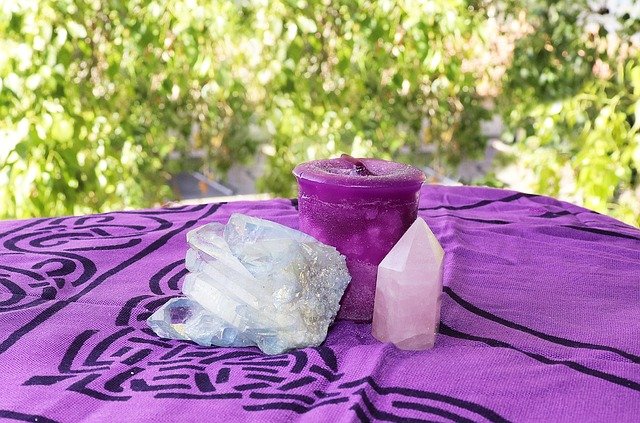Good morning!
If you’re like most people, you have at least one person close to you who will occasionally come out with some completely bonkers, destructive nonsense. Unproven conspiracy ideas like, “vaccines are a conspiracy to implant tracking chips in everyone (posted from iPhone)” or “Jewish people caused the oil crisis by always getting their groceries double-bagged at King Kullen.”
(I have heard both of these unironically from actual human people.)
You might think this person is mostly cool, save for one or two beliefs that you’d swear were the byproduct of some kind of brain worm. You might also just be obligated to spend time around them, because you’re a dependent and they’re related to you. Maybe you just hold out hope that they’ll someday become the people they were before they got wrapped up in the fringe. If trying to talk to them or send them actual empirical data doesn’t work, here are the best crystals you can strategically plant wherever you’re forced to interact with them:
Lapis lazuli
Lapis has a hell of a reputation. For one, it’s been used in everything from cosmetics to artistic masterpieces, so it has some strong associations with creativity and expression. It’s also blue, which people who work with chakras will recognize as the color of Vishuddha, the throat chakra. (It rules expression and communication.) This means that it’s a pretty rad stone to have on you when you’re forced to defend yourself against accusations of being a NWO shill or secret lizard person from space.
Lapis has another talent, though. It’s often called the “Stone of Truth.” Its energy is said to help the user uncover hidden truths, both about themselves and the people and things around them. Most of us wouldn’t necessarily consider the idea that multi-level marketing schemes are a scam designed to profit off of people’s desperation to be a “hidden” truth, but you’ve got to meet people where they are.
Emerald
Now, I’m not suggesting that you drop a bunch of dosh on a fancy table-cut emerald to cram under your uncle’s recliner this Thanksgiving. You can get tumbled emeralds that aren’t gem quality, but are still emeralds and will still work for our well-intentioned-yet-nefarious purposes.
The idea here is that emeralds are tied to the heart. People who work with chakras consider them a stone for Anahata, the heart chakra. Even if Hindu tantrism isn’t your jam, emerald has a reputation as a stone for love and compassion. (Like instilling more compassion in the hearts of those around you who have notions about a super secret “gay agenda,” for example.)
According to color magic, green is also associated with growth. This is typically taken to mean increase, as in an increase in prosperity, fertility, and so forth. But green is associated with growth because of its connection to plants and nature — a lush, green plant is a successful, healthy, thriving one. You can empower a tumbled emerald to help your family grow and develop as people before you hide it behind the TV.
Amethyst
I don’t think I’ve ever seen a list of calming, meditative crystals that didn’t include amethyst somewhere. There’s a reason for that. This stone is associated with things like divination and meditation, sure, but it’s also very relaxing and enhances a person’s connection to their intuition. (That means that it might be able to amplify the tiny voice inside your grandpa that says that maybe Democratic Socialists aren’t coming to take his toothbrush.)
Amethyst is also credited with increasing the user’s spiritual awareness and guarding against psychic attacks.
Smoky Quartz
Smoky quartz is pretty much clear quartz that, like Bruce Banner, was exposed to radiation and came away with some extra powers. It’s said to be helpful for grounding, as well as filtering energy and transmuting the negative into the positive. This means that it can help keep things on a smooth, even keel when Aunt Karen gets a couple of glasses of eggnog in her and starts ranting about immigration.
Rose Quartz
Ah, rose quartz. Any love-drawing crystal spell or list of stones for heart-related matters is basically guaranteed to include this pink stone. The thing is, it’s good for a lot more than just flowery, hearts-and-chunky-angel-babies romantic love. It’s also very rad for compassion, friendship, and familial love.
Like emerald, it can be helpful for getting people to meet you where you are. It can encourage the opening of hearts and minds. While lapis is a better choice for getting people to see the truth, rose quartz is better for getting them to see people as people, with the same pain, fear, hope, and aspirations as they have.
Black tourmaline
Like smoky quartz, black tourmaline is a weapon against negativity. It’s a very powerful energy filter, and can help neutralize bad vibes. Large specimens (especially ones intermingled with spangles of golden mica) look extremely cool, which means they’re great for keeping in your own living spaces to ensure that nobody’s bullshit sticks around to bother you. Smaller stones are good for keeping on you as a protective amulet, or, as the title suggests, stashing around anywhere you’re forced to be.
As an FYI, crystals that act as energy filters need regular, thorough cleansing. Think of them like vacuums — they can suck negativity up, or even transmute it into positive energy, but that canister’s gotta get emptied sometime. The more crap they come in contact with, the sooner they’ll need to be recalibrated with a cleansing.
Spirit Quartz
Spirit quartz also goes by the names cactus quartz and fairy quartz. These are quartz points (usually amethyst or citrine) that are entirely covered in tiny, druzy points. This makes them all spiky, like cacti.
Spirit quartz help in a number of ways. Amethyst is a stone for introspection and harmony, as was mentioned above. All of those tiny points effectively amplify this energy and send it out everywhere. The druse also symbolizes many tiny units working together in a cohesive whole, so it’s great for fostering feelings of community and cooperation.
Amethyst spirit quartz is also said to be particularly helpful for getting rid of negative attachments or entities. It can’t get rid of the weird radicalizing podcasts your cousin insists you check out, but it can help pull their hooks out of him.
As with anything involving crystals, make sure yours come from an ethical source. Sadly, much of the mining trade (not even just the crystal trade — a lot of crystals are byproducts of mining for gold, platinum, lithium, and other materials used by the electronics industry) relies on exploited labor and environmentally damaging methods. Always know where your stones came from, and how they got to you.
Many, if not most, sources say that it’s unethical to perform magic or energy work on someone without their consent. While it’s nice to abide by the rules, sometimes you have to do the wrong thing to get the right thing done. The energetic toll of trying to get someone to be less hateful, or less absorbed in destructive conspiracy theories and hoaxes, is going to be way less than, say, casting a love spell on an unwilling target. Use your own judgment. If you belong to a marginalized group and need to do something to keep yourself safe and sane, do it.











